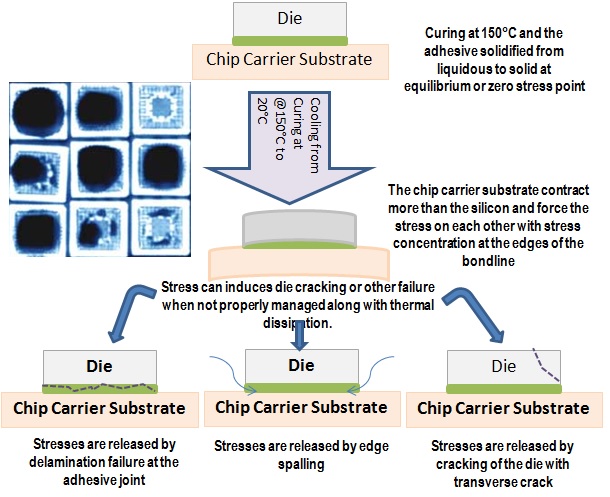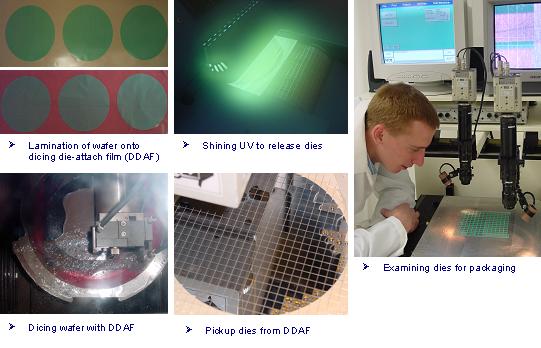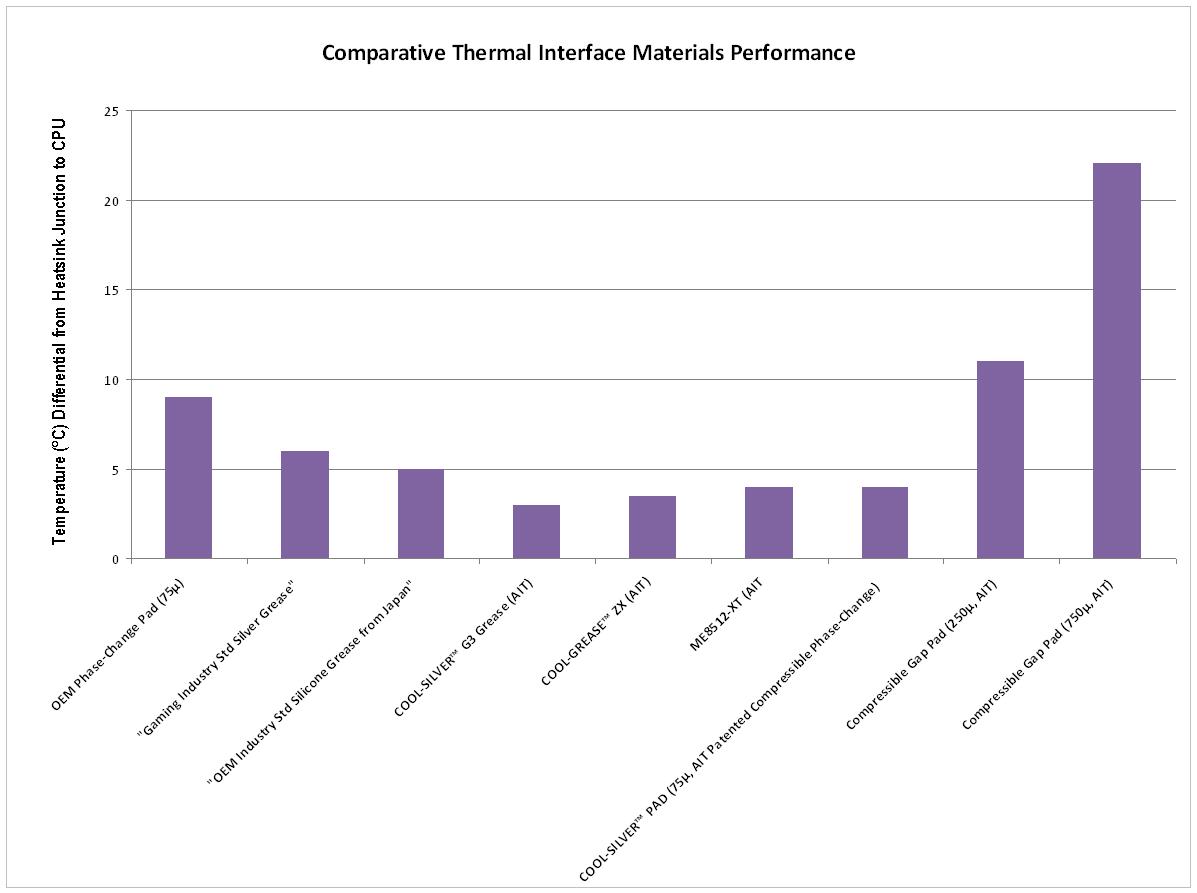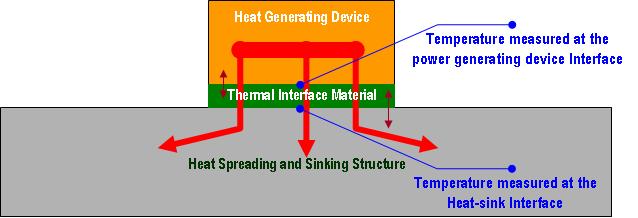Explore More:
Read more about Specialty Die Attach Applications here
AIT engineering, sales and service:
1-609-799-9388 or Fax: 609-799-9308
Dicing Die-Attach Film (DDAF) or Dicing Die-Attach Tape (DDAT)
Chip Scale Packaging, Stack-Chip Packaging, Through Silicon (STV) Via Filling and Underfill
AI Technology, Inc. pioneered the use of flexible die-attach film and paste adhesives for larger chip and die bonding in the early 1980s. The company has since found success in extending its adhesive line to offer the widest selection in the industry. AIT die-bonding film adhesives have been designed for a combination of performance and manufacturing efficiency.

Balancing high Tg for ease of wire-bonding and molding and the stress relief capability in die-attach adhesive is critical for the reliability and carefully engineered into AIT die-attach adhesives
The following are a few examples:
1. Rapid-curing die-attach adhesive paste for typical dies:
- Rapid curing at 150-250°C in seconds
- Maintains more than 300 psi bond strength @ 250°C for fast wire-bonding
- Molecularly engineered for low moisture absorption and high temperature stability
- Designed for dies less than 1 cm
- Examples: ME7635-RC, ME8630-RC
- Ultra-High Temperature, 300°C continuous use paste adhesives
- Examples: MC7888, MC8880
2. Rapid-curing die-attach adhesive paste for large dies:
- Rapid curing at 150-250°C in seconds
- Maintains more than 300 psi bond strength @ 150°C for typical wire-bonding
- Molecularly engineered for low moisture absorption and high temperature stability
- Designed for dies larger than 1 cm
- Examples: ME7655-RC, ME8650-RC
3. Rapid-curing die-attach film (DAF) adhesive for stack chip packaging:
- Tacks at 80-150°C in seconds with minimal pressure of 4-8 psi
- Rapid curing without pressure at select temperatures
- Maintains more than 300 psi bond strength @ 250°C for fast wire-bonding
- Molecularly engineered for low moisture absorption and high temperature stability
- Designed for dies less than 1 cm
- Examples: ESP7670-WL, ESP8680-WL
- Ultra-High Temperature, 300°C continuous use applicable film adhesives
- Examples: CXP7888, CXP8880
4. Rapid-curing die-attach film (DAF) adhesive for reliable stacked chip packages with large dies:
- Tacks at 125-150°C in seconds with minimal pressure of 4-8 psi
- Rapid curing without pressure at select temperatures
- Maintains more than 300 psi bond strength @ 150°C for typical wire-bonding
- Molecularly engineered for low moisture absorption and high temperature stability
- Designed for dies larger than 1 cm
- Examples: ESP7450-WL, ESP8450-WL
AIT technology has the capability of combining its UV-releasing dicing tape (UVR 250) and its rapid-curing in-line “Tack-and-Cure” die-attach film adhesive (ESP7660, CXP7860) for the ultimate in manufacturability for stack-chip packages.

AIT Dicing Die-Attach Film (DDAF) differs from the more traditional B-staged film adhesive due to a unique molecular structure for fast melt-flow that allows for low temperature and low pressure tacking and then post-curing without pressure.
Other Specialty Die Attach Applications
1. Screen-printable rapid-curing die-attach film (DAF) adhesive:
- Screen-printable
- Tacks at 80-150°C in seconds with minimal pressure of 4-8 psi with rapid curing without pressure at select temperature
- Alternative inline tack-and-curing at 250°C within seconds
- Maintains more than 300 psi bond strength @ 250°C for fast wire-bonding
- Molecularly engineered for low moisture absorption and high temperature stability
- Designed for dies less than 1 cm
- Examples: LESP7670-WL, LESP8680-WL
2. Ultra-high thermally conductive die-attach adhesive pastes:
- Proven for military electronics and thermal performance
- Molecularly engineered for high temperature stability
- Designed for large and small dies
- Examples: ME8456-DA, ME8650-RCT
3. Ultra-high temperature stable die-attach film & paste adhesives for 300°C continuous applications:
- Molecularly engineered interpenetrating network film and paste adhesives for military electronics and high temperature electronics
- Molecularly engineered for high temperature stability and low CTE with high moisture resistance
- Designed for large and small dies
- Examples of paste die-attach adhesives: MC7888, MC8880
- Examples of film die-attach adhesives: CXP7888, CXP8880
4. Flip-Chip Direct Contact Attach Film and Liquid Underfill for stack chip packaging and through silicon via (STV) filling:
- Molecularly engineered interpenetrating network film and paste adhesives for military electronics and high temperature electronics
- Molecularly engineered for high temperature stability and low CTE with high moisture resistance
- Designed for large and small dies
- Examples of flip-chip direct attach film and paste adhesives: CM7880, CXP7880-UF

Comparison of Thermal Interface Materials Performance: Lower temperature rise represents a measurement of the efficiency of the thermal interface materials in transferring heat generated by the power electronic device to the heatsink (with fan) that dissipates heat to the environment by the forced circulating air. The thickness of the thermal interface material also contributes significantly to the efficiency of heat dissipation and should be minimized as much as the physical configuration or construction permits. The effectiveness of a specific thermal interface material cannot be easily predicted by the claimed or even measured bulk thermal conductivity data or value. The thermal resistance at the thermal interface material to the substrates in their respective interfaces for thin bondline or interface thickness is significant and represents the “coupling efficiency” that cannot be predicted and must be measured.

The data in the comparison of thermal interface materials is collected by using an Intel CPU and forced air heatsink as represented in the above configuration. A thermocouple is drilled and embedded at the heatsink junction that interfaces with the thermal interface material to provide direct temperature data at the interface for measuring the “coupling” of the specific thermal interface materials to the heatsink.
AIT engineering, sales and service:
1-609-799-9388 or
Fax: 609-799-9308
